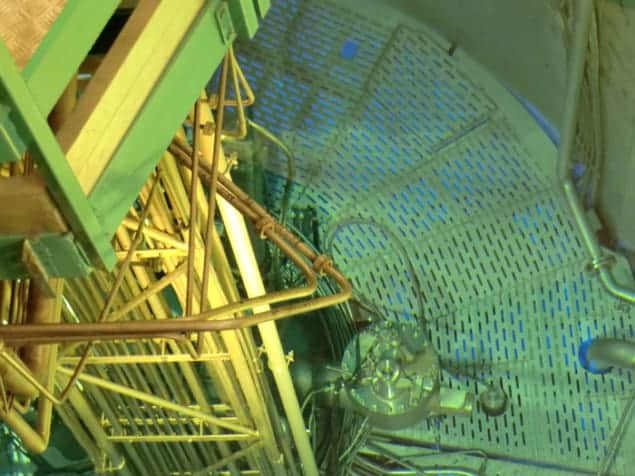
Physicists in France and Russia claim to have evidence that explains why so-called ultracold neutrons (UCNs) escape their traps. The evidence suggests that the neutrons are being kicked out of the traps by collisions with floating nanoparticles and could help explain discrepancies in measurements of the neutron lifetime. However, not all scientists in the field find the evidence compelling.
UCNs are neutrons that have been cooled to less than 2 mK above absolute zero. At these temperatures the neutrons are moving so slowly that they would easily be overtaken by someone running at a moderate pace. UCNs bounce off most surfaces they come into contact with, regardless of their angle of incidence. This has allowed physicists to trap large numbers of UCNs in oversized “bottles” made of materials such as copper or stainless steel – where the neutrons can be studied. Neutrons experience all four forces – electromagnetism, the weak force, the strong force and gravity – which make them a comprehensive laboratory for tests of the Standard Model of particle physics.
One quantity of great interest is the lifetime of the neutron, which is determined by the weak force. Although neutrons last for billions of years when bound within nuclei, free neutrons are known to decay into protons (with the emission of an electron and an electron-antineutrino) with a half-life of about 10 minutes. A precise value of the half-life is obtained by trapping UCNs in bottles and then counting how many of the particles are left after a certain time interval. Such measurements have been done by several different research groups and their results currently differ by about one second.
Vibrating nanoparticles
Some of the discrepancy could be caused by UCNs leaking from the rims of their bottles. The problem with this explanation is that once inside a bottle, a UCN should not be travelling fast enough to escape the downward pull of gravity. In 1999 physicist Valery Nesvizhevsky at the Institut Laue-Langevin (ILL) in Grenoble, France and colleagues suggested that the UCNs could collide with nanoparticles that are floating within a bottle and vibrating nanoparticles that stuck to the inner surfaces of the bottles. Unlike most collisions with the bottle surfaces, these collisions could give the neutrons enough energy to rise out of the bottle.
Now Nesvizhevsky and colleagues believe they have evidence that this is really the case. The researchers developed a theoretical model to predict the spectrum of UCN energies that would be generated if nanoparticles of different sizes were indeed supplying an extra kick at some surface collisions. Then the researchers looked to confirm their model by doing experiments at ILL, which produces UCNs. The experiment involves a 2-m-tall copper bottle that the team coated on the inside with nanoparticles of a known size distribution. The UCN energy spectra from these experiments appeared to match the theoretical predictions.
“This is indeed an interesting new idea for a possible loss mechanism of UCNs on the surfaces of material traps,” says experimental nuclear physicist Mike Snow at Indiana University Bloomington in the US. He believes Nesvizhevsky and colleagues’ mechanism might need to be taken into account in bottle experiments, although he points out that newer neutron-lifetime experiments are employing magnetic-field traps. These would probably be less susceptible to the mechanism, he says.
Does water do the same?
But not all UCN experts agree that Nesvizhevsky and colleagues’ mechanism is convincing. Stephan Paul and Erwin Gutsmiedl at the Technical University of Munich in Germany told physicsworld.com that they have estimated that water on the bottle walls could also reproduce the findings. “The feeling at present is that there’s no proof the scenario Nesvizhevsky proposes for his observation is the correct one,” says Paul.
Robert Golub at North Carolina State University in Raleigh, US agrees. He points out several potential issues, including that scientists routinely clean the surfaces of their bottles prior to performing experiments, a procedure that would remove any freely floating nanoparticles. If the nanoparticles are being generated on-site, he says, then Nesvichevski and colleagues would have to explain how they are generated. “The hypothesis that surfaces of materials are covered by a 2D gas of floating nanoparticles seems highly unlikely to say the least,” he adds.
The research is published in Crystallography Reports 58 743.



